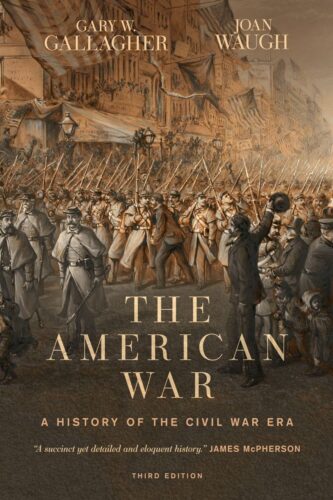
The American War: A History of the Civil War Era
In The American War: A History of the Civil War Era, renowned historians Gary W. Gallagher and Joan Waugh provide a fresh examination of the Civil War, the great defining moment in U.S. history, as well as its aftermath and enduring memory, in a masterful work that prize-winning historian William C. Davis calls “easily the best one-volume assessment of the Civil War to date.”
By investigating this crucial period of U.S. history through the eyes of civilians, celebrated leaders, and citizen soldiers alike, students and curious readers alike can gain a profound understanding of the dramatic political and military events and personalities as well as social and economic processes that caused the Civil War, enabled the Union to prevail over the Confederacy, and forever transformed the United States.
Third Edition Now Available!

The American War: A History of the Civil War Era
In The American War: A History of the Civil War Era, renowned historians Gary W. Gallagher and Joan Waugh provide a fresh examination of the Civil War, the great defining moment in U.S. history, as well as its aftermath and enduring memory, in a masterful work that prize-winning historian William C. Davis calls “easily the best one-volume assessment of the Civil War to date.”
By investigating this crucial period of U.S. history through the eyes of civilians, celebrated leaders, and citizen soldiers alike, students and curious readers alike can gain a profound understanding of the dramatic political and military events and personalities as well as social and economic processes that caused the Civil War, enabled the Union to prevail over the Confederacy, and forever transformed the United States.
Third Edition Now Available!
New to the Third Edition
To keep up with current scholarship on the Civil War and Reconstruction periods, new or revised material has been incorporated throughout The American War on the following topics:
- Chapter 3: Guerrilla Warfare
- Chapter 8: The Struggle for Women’s Voting Rights
- Chapter 9: Did the War End in the Spring of 1865?
- Chapter 11: Was Reconstruction a Lost Moment?
- Chapter 12: Acknowledging the War’s Dark Side
- Further reading: More than two dozen additional titles that combine accessibility and sound scholarship, including thirteen in a new section devoted to photographs and art
Sample the Digital Text
The American War: A History of the Civil War Era is available to sample now on Bookshelf, VitalSource’s digital platform.
Available Now
ISBN: 979-8-9858492-9-5 – VitalSource Digital-only — $39.00
ISBN: 979-8-9858492-7-1 – Paperback – $44.95 retail (20% bookstore discount – $35.96)
ISBN: 979-8-9858492-6-4 – VitalSource Paperback/Digital Bundle — $49.00 retail (20% bookstore discount – $39.20)
Campus bookstores can place digital-only purchase orders directly via VitalSource’s catalog. For paperback or paperback/digital bundle orders, please contact our Order Fulfillment team directly (orders@fliplearning.com).
Request Free Access
Digital Features
The interactive version of The American War includes the following features:
- Filmed debates between the others on topics such as the “inevitability” of secession, war, and Confederate defeat.
- 40+ interview-style videos embedded within the textbook, including a dozen that feature Gary Gallagher on location at several battlefield sites.
- 100+ hyperlinks to important online resources.
- PowerPoint slide presentations available as an instructor resource at the end of each chapter.
- Chapter quizzes available for easy upload to any LMS.
- Embedded reading comprehension questions.

Table of Contents
This chapter surveys the late antebellum period and carries the narrative through the election of Lincoln, the secession of the Lower South, and the firing on Fort Sumter.
This chapter covers the secession of the Upper South, the struggle for the Border States, and the mobilization of resources, strategic planning, and early military campaigns. It addresses factors such as manpower, industrial capacity, geography, historical precedent, and European reaction as elements in handicapping the conflict.
This chapter charts the huge swings of momentum on the battlefield between the winter of 1861 and the winter of 1862; introduces students to key figures such as U. S. Grant, R. E. Lee, and George B. McClellan; discusses battles such as Shiloh, the Seven Days, and Antietam; and brings to the fore the concept of contingency.
This chapter explores the profoundly important concept of the citizen-soldier-which played an equally critical role in both the United States and the Confederacy. More than half of all men who served were true volunteers who entered service before conscription had been imposed.
This chapter builds on material in earlier chapters to explore the process by which emancipation came to be a non-negotiable war aim for the United States. It makes clear that until very late in the conflict emancipation was uncertain-the war could have ended with slavery largely intact and with few black men in uniform.
This chapter focuses on the year that often is described as the time when fortunes turned irrevocably toward United States victory-with Gettysburg and Vicksburg serving as twin turning points that doomed the Confederacy. In this chapter, a more complex reading of the period is presented-which also included massive anti-draft and anti-African American riots in New York City that highlighted political turmoil on the Union home front and continuing resolve across much of the Confederacy.
This chapter describes the sense of nation that imbued both war efforts, the massive expansion of central power in the Confederacy, the impressive– but less striking–expansion of federal power in the United States, and the need to engage the conflict as a war between two modern nation states rather than as a bloody uprising by one segment of the American population.
This chapter examines the varying experiences of different groups of women, white and black, behind the lines in the United States and the Confederacy (proximity to armies played a crucial role here). It explores the movement of women into different workspaces, black and white refugees in the Confederacy, and the degree to which women supported the respective war efforts.
This chapter examines the last year of the war with a focus on U. S. Grant’s strategic planning and execution. It reinforces the theme of contingency, showing how the summer of 1864 represented the lowest point of Union morale for the war and how emancipation, even at that late date, was not a sure thing.
This chapter describes the peace agreement signed at Appomattox Court House in 1865 that achieved the United States’ goals of reunion and emancipation, and then explores the aims of northern whites, southern whites, and the freed people in the immediate aftermath of war.
This chapter examines how Republicans fared in implementing congressional Reconstruction in the southern states from 1868 to 1876.
This chapter outlines the emergence of the major memory traditions of the Civil War — Union, the Lost Cause, Emancipation, and Reconciliation.
